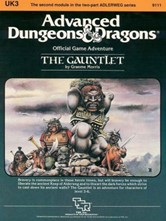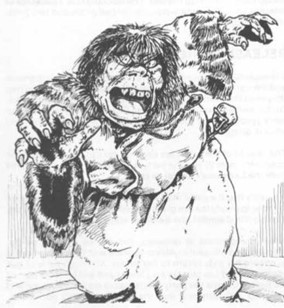 I’m writing this review thirty years after UK3: The Gauntlet came out. This adventure is part two of the two-part Alderweg series. I was not particularly kind in my review of the first part of the series, The Sentinel. I did not enjoy it when I first read it back in the 80s, and I don’t particularly enjoy it today. It’s not a terrible adventure, but I find it a fairly boring one.
I’m writing this review thirty years after UK3: The Gauntlet came out. This adventure is part two of the two-part Alderweg series. I was not particularly kind in my review of the first part of the series, The Sentinel. I did not enjoy it when I first read it back in the 80s, and I don’t particularly enjoy it today. It’s not a terrible adventure, but I find it a fairly boring one.
I have a much more positive impression of The Gauntlet. It’s still not one of my favourite adventures, but it attempts some really interesting things. The adventure is not a straightforward dungeon-crawl!
The basic set-up is that an evil artefact, known as the Gauntlet, was created to destroy the Keep of Alderweg. The defenders of the keep created their own artefact to oppose it, the Sentinel. This occurred a long time ago, and eventually both artefacts were lost and forgotten. However, the Gauntlet was found by an ogrillon, who was enslaved by the artefact. The Gauntlet has captured the ill-defended keep in recent days and is now trying to build up a powerbase in the area. As part of its plan, it wants to move to a more powerful wearer and so has captured the daughter of a local fire giant; it intends to transfer to the fire giant.
Meanwhile, the player characters have regained the Sentinel, either in the first adventure in the series or in a short alternative encounter given in the text of this adventure, and have come to the aid of the Keep. The first part of the adventure deals with their journey to the keep, in which they come across a village that has recently been overrun and slaughtered by a raiding part of gnolls and war-dogs. Strangely enough, the raiders have no connection to any of the other parties in the adventure; I suppose this encounter is designed to show how dangerous the humanoids can be, as well as to impart some information about what is going on at the keep. It does the latter by allowing a wounded gnoll chieftain to be found and interrogated. He knows a few details about what is going on at the keep, but not everything he believes is true! It’s a very nice touch, and something that would be nice to see in modern adventures.
Infiltrating the keep takes the majority of the adventure. As storming the front gates would likely be a suicidal plan, it’s just as well that the Sentinel knows of a disused entrance into the keep. It’s not free of danger, as a colony of giant ants has made their home there and may accidentally set off some of the magical defenses as the players make their way through the Undercroft, but it is the upper levels that are more concern. They hold about thirty gnolls, an ogre and the ogrillon overlord, and the adventure makes particular note of how the gnolls react to intruders as well as the defensive features present in the keep.
 These defenses become quite relevant in the third part of the adventure, where the Keep comes under attack from the Fire Giant and his troops who are furious at the Ogrillon (who has “escaped” into a magical prison) for stealing the giant’s daughter. Together with the survivors of the gnoll attack, four men-at-arms that the players can rescue, the player characters now need to defend the keep long enough for the giant to actually start talking to them. As a teenager, I was terrified of running this section. There are about 180 attackers! For characters of levels 3-6, this would seem to be certain death! As an experienced DM now of thirty years’ experience, I now understand that the purpose of the attack is to build excitement and tension, not to slaughter the party, and I’d be a lot better at running it!
These defenses become quite relevant in the third part of the adventure, where the Keep comes under attack from the Fire Giant and his troops who are furious at the Ogrillon (who has “escaped” into a magical prison) for stealing the giant’s daughter. Together with the survivors of the gnoll attack, four men-at-arms that the players can rescue, the player characters now need to defend the keep long enough for the giant to actually start talking to them. As a teenager, I was terrified of running this section. There are about 180 attackers! For characters of levels 3-6, this would seem to be certain death! As an experienced DM now of thirty years’ experience, I now understand that the purpose of the attack is to build excitement and tension, not to slaughter the party, and I’d be a lot better at running it!
The finale of the adventure comes as the party try to release the fire giant’s daughter and the ogrillon (and The Gauntlet) from the prison where they’re hidden; there are one or two surprises here before everything comes to a conclusion.
Plot-wise, this is a strong adventure. I’m struck by similarities to the recently-released Payback, which I reviewed a couple of days ago. Both involve the characters taking over a keep and then defending it against an attack. However, The Gauntlet just feels so much tighter and more ambitious. I made note of how mundane I found the keep in Payback, and it’s quite true that there isn’t much of the way of magical tricks in the keep in The Gauntlet either. Why doesn’t it bother me as much? Perhaps it’s because the keep in The Gauntlet is much smaller and its dangers more focused. Then too, the infiltration both begins and ends with unusual events: the ants and the magical traps, the ogrillon disappearing into a magical prison. The Gauntlet feels much more special as an adventure.
I find the production values of the adventure fairly poor; the layout is ugly and the less said about the art the better, as I really dislike the style it is executed in. (The physical paper and cardboard it was printed on have held up well).
As with all of the UK-produced adventures for AD&D by this time in their history, the sense of story is very strong. The fantastical elements are somewhat subdued, which at times makes it an odd fit against what other designers were producing, but I can’t really argue with the results: The Gauntlet is one of the better AD&D adventures of the day, although I would say it benefits greatly from an experienced DM at the helm.

About to run this.
Gauntlet and its predecessor Sentinel are strong modules. Solid plots, a combination of mystery and exploration to start followed by plenty of combat to finish. There is the danger of TPK at the end of Gauntlet, but only if the party does not utilize the keeps’ formidable position and defenses, and the DM uses the ending assault to build drama as the Party repels the first attack so carefully described in the notes.
The story is linear, as most good plot-driven adventures are. I have never really understood complaints about adventures that see characters experiencing a story. Pure hack-and-slashers probably have faster moving games to play than D&D.
I like that the author used monsters from the often ignored Fiend Folio, a product that sat on my shelf unused for years due to its low quality art. These modules have me rereading and appreciating FF’s content much more than in my youth.
This has always been one of my favorite adventures. I agree about the artwork since I’ve always found the vast majority of D&D art in the UK products to be horrible. But there are two artistic elements that I like a lot.
First is the castle maps. They have a very interesting layout and are realistic (thick walls, narrow arrow slits, upper levels that correspond to lower levels, and so on).
Second, definitely like the illustrations of the keep that exactly match what the layout of the keep really is. TSR product too often (especially in 1e and 2e) have illustrations of fortresses that in no way resemble their internal layout on pages 7, 9, and 31. It’s as if the artists were just told “draw a castle” without being able to look at the interior maps ahead of time. These types of accurate illustrations are always nice to have, but they are especially important in this adventure since the PCs need to have an overall idea of what the place looks like in order to quickly determine how to defend it against those besieging the castle in the latter half of the adventure.